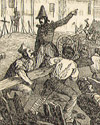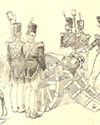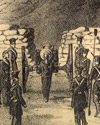19th Century´s militar history in the Basque Country
The liberal artillery
 This war saw the most dramatic evolution of the artillery arm. At the start of the conflict, Spain had no mountain artillery, but ten months later, the Liberal army had 16 fully-assembled units. These were 8-pdr cannons and 7-pdr howitzers, with little capacity for destruction.
This war saw the most dramatic evolution of the artillery arm. At the start of the conflict, Spain had no mountain artillery, but ten months later, the Liberal army had 16 fully-assembled units. These were 8-pdr cannons and 7-pdr howitzers, with little capacity for destruction.
To supply the northern front, an arsenal was set up in Burgos with small stores in Vitoria, Logroño, Bilbao and San Sebastián.
 The most important changes in the artillery unit took place in 1838 under the command of General Alaix. The use of 12-pdr howitzers, like those of the French Foreign Legion, was adopted.
The most important changes in the artillery unit took place in 1838 under the command of General Alaix. The use of 12-pdr howitzers, like those of the French Foreign Legion, was adopted.
Towards the end of the war, the Liberal army had a significant stock of light units, plus 104 pack and 64 towed artillery.
 Almost all fixed units were in Liberal hands, since they controlled the main military garrisons throughout the war.
Almost all fixed units were in Liberal hands, since they controlled the main military garrisons throughout the war.
The superiority of the Liberal artillery was a key factor in the failure of the sieges of Bilbao and as a result, the general outcome of the war, because the defenders of the city always had greater artillery strength than their Carlist besiegers.

